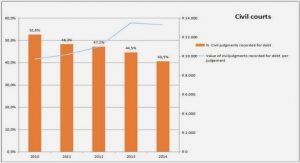Get Complete Project Material File(s) Now! »
Contingent valuation methods
Contingent valuation methods (CVMs) involve directly asking people, usually in a survey, how they interpret the damage that has occurred or might occur to the environment. CVMs are based on people’s willingness to pay (WTP) for an improved situation, or willingness to accept compensation (WAC) for a worse situation (Van Horen, 1996). CVMs fall under ‘stated preference’ methods, because they require people to state their values, rather than approximate values from actual choices. The valuations are performed with an assumption that the public involved in the methodology have a fair idea about market dynamics. However, this method is controversial as the monetisation of willingness in either context is subject to the individual’s perception and ability. An example of such a scenario would be a situation where inhabitants of a municipality are asked to decide on how much they would be willing to pay to conserve a fishing habitat. The valuation could for instance be influenced by an individual’s preference for fishing. The willingness to pay and to accept compensation will be different among developed and developing economies based on nominal GDP (Gross Domestic Product) and PPP (Purchasing Power Parity) (Cooper, 1981). This difference can be explained by a comparison between a rich and a poor person who has to pay the same amount for an improved environmental situation. The poor person will be more reluctant to part with the valuation than the richer person. This comparison can also be extended to countries with different economic capabilities.
Eskom in a national and international context
South Africa’s recent and past history has seen continuous innovations and shifts in the energy industry. South Africa was the first country in the southern hemisphere and Africa to introduce street lighting, in the town of Kimberly in 1882 (Eskom, 2009). One of Eskom’s innovations has been the Airborne Laser Solutions technology that conducts high speed and accurate linear surveys of thousands of kilometres’ transmission lines over difficult terrain. Eskom’s pioneering dry tower cooling power technique is employed in three out of ten base load coal power plants. Two new base load coal power plants that are currently under construction, Kusile and Medupi, are employing the latest desulphurification techniques. When operational Medupi will be the world’s fourth largest coal power plant and the largest power plant employing dry cooling techniques.
Table 3.4 describes different phases of Eskom’s operations. Eskom has over the past century grown to become one of the top 10 electricity supplying utilities in the world. Eskom was incepted in 1923 with the establishment of the Electricity Supply Commission (Escom) by the government. The period from 1930 to 1950 saw Escom trying to lay solid foundations by erecting governance structures and establishing basic electrification infrastructure to facilitate national supply. The Klip power station was built to cater for the increasing demand for electricity from the mining industry. World War II adversely affected Escom’s functioning, but the challenges were overcome once the war ended, with Escom being able to acquire and expand existing regional power stations, such as the Port Shepstone power station and municipal undertakings in the present day region of the Eastern Cape. Several extensions to existing levels of infrastructure were made to supply increasing demand.
Chapter 1: Introduction
1.1 Background
1.2 Research objective
1.3 Methodology
1.4 Description of thesis
Chapter 2: Literature review
2.1 Introduction
2.2 Externality evaluation techniques
2.3 The ExternE Project: A brief history
2.4 South African externality studies
2.5 Discussion
2.6 References
Chapter 3: Energy and electricity policy in South Africa: An overview
3.1 Energy industry in South Africa
3.2 Electricity policy in South Africa: A timeline
3.3 Eskom in a national and international context
3.4 Types of electricity generation in South Africa
3.5 Summary
3.6 References
Chapter 4: Public health impacts
4.1 Introduction
4.2 Externality valuation
4.3 Discussion and uncertainty
4.4 References
Chapter 5: Environmental impacts
5.1 Greenhouse gas emissions
5.2 Water usage
5.3 References
Chapter 6: Occupational health impacts
6.1 Occupational health in coal mining
6.2 Nuclear externalities
6.3 References
Chapter 7: Conclusion
7.1 Summarised external costs
7.2 Contributions
7.3 Uncertainties
7.4 Recommendations
7.5 Case study of South African electricity prices
7.6 The policy way forward
7.7 References






